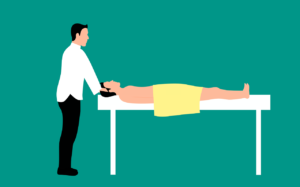
Are you tired of waking up with a sore neck every morning? If so, you’re not alone. Many people suffer from neck pain after sleep, which can make it difficult to start the day on the right foot. But fear not, because there are simple and effective ways to alleviate this discomfort. In this article, you will discover some tried and tested methods to help relieve neck pain after sleep, providing you with the comfort and relaxation you need for a productive day ahead. Say goodbye to those nagging morning aches and hello to a rejuvenated neck!

Causes of Neck Pain After Sleep
Improper sleeping position
One of the common causes of neck pain after sleep is an improper sleeping position. If you sleep in a position that puts strain on your neck, such as sleeping on your stomach with your head turned to the side, it can lead to discomfort and stiffness in the neck muscles.
Old or sagging mattress
An old or sagging mattress can also contribute to neck pain after sleep. A mattress that is not providing adequate support to your body can cause your neck to be twisted or bent in an unnatural position, leading to pain and discomfort.
Pillows that do not provide proper support
Using pillows that do not provide proper support to your neck can also be a cause of neck pain after sleep. If your pillow is too high or too low and does not provide adequate support to your neck and head, it can strain the muscles in your neck and lead to pain.
Sleeping on a too-high or too-flat pillow
Sleeping on a pillow that is either too high or too flat can also result in neck pain after sleep. If your pillow is too high, it can tilt your head upward and strain your neck muscles. On the other hand, if your pillow is too flat and does not provide proper elevation, it can cause your neck to bend downward and lead to discomfort.
Muscle strain or tension
Muscle strain or tension in the neck can be another cause of neck pain after sleep. This can occur from activities during the day that put stress on the neck muscles, such as prolonged sitting at a desk or engaging in activities that require repetitive neck movements.
Sleeping on a hard or uneven surface
Sleeping on a hard or uneven surface can also contribute to neck pain after sleep. When your neck is not properly supported by the surface you sleep on, it can lead to discomfort and stiffness.
Underlying medical conditions
There are certain underlying medical conditions that can cause neck pain after sleep. Conditions such as osteoarthritis, cervical spondylosis, and herniated discs can cause inflammation and pain in the neck, which may be aggravated during sleep.
Sleeping with excessive or incorrect pillows
Sleeping with excessive or incorrect pillows can also be a contributing factor to neck pain after sleep. Using too many pillows or using pillows that are too soft or too firm can result in poor neck alignment and strain on the neck muscles.
Using a thick or oversized pillow
Using a thick or oversized pillow can also lead to neck pain after sleep. These types of pillows can force your neck into an unnatural curve, straining the neck muscles and causing discomfort.
Inadequate sleep quality
Lastly, inadequate sleep quality can also play a role in neck pain after sleep. If you are not getting enough deep and restorative sleep, your muscles may not have enough time to relax and recover, leading to increased tension and pain in the neck.
Prevention of Neck Pain After Sleep
Choosing the right pillow
To prevent neck pain after sleep, it is crucial to choose the right pillow. Opt for a pillow that provides adequate support to your neck and aligns your head with your spine. The ideal pillow depends on your sleeping position, so consider a cervical pillow, memory foam pillow, or an adjustable pillow to find the best fit for you.
Adopting a proper sleeping position
Having a proper sleeping position is important for preventing neck pain after sleep. Aim to sleep on your back or side, as these positions help maintain the natural curve of your spine and keep your neck in a neutral position. Avoid sleeping on your stomach, as it can strain your neck muscles.
Using a supportive mattress
Ensure that your mattress provides proper support to your body. A supportive mattress will help distribute your weight evenly and prevent your body from sinking into uncomfortable positions.
Replacing an old or sagging mattress
If you have an old or sagging mattress, consider replacing it. An old mattress may have lost its ability to provide adequate support, which can contribute to neck pain after sleep.
Maintaining a good sleep posture
Maintaining a good sleep posture is essential for preventing neck pain after sleep. Avoid slumping or slouching while sleeping and focus on keeping your neck and spine aligned.
Exercising and stretching before bed
Engaging in gentle exercises and stretching before bed can help relieve tension and promote relaxation in your neck muscles. Consider incorporating neck stretches, shoulder rolls, and upper back stretches into your pre-bedtime routine.
Avoiding excessive pillow usage
Using too many pillows can put your neck in an uncomfortable position, leading to neck pain after sleep. Stick to using one or two pillows that adequately support your head and neck.
Creating a suitable sleep environment
Create a sleep environment that promotes relaxation and comfort. Keep your bedroom dark, quiet, and at a cool temperature. Consider using earplugs, eye masks, or white noise machines to block out distractions that may disrupt your sleep.
Managing stress and anxiety
High levels of stress and anxiety can contribute to muscle tension and neck pain. Practice stress management techniques such as deep breathing, meditation, or mindfulness exercises to help you relax before bed.
Sleeping adequately
Making sure you get enough sleep is crucial for preventing neck pain. Aim for 7-9 hours of quality sleep each night to allow your body and muscles to rest and rejuvenate.
Immediate Home Remedies for Neck Pain
Applying heat or cold therapy
Applying heat or cold therapy to your neck can help alleviate pain and reduce inflammation. Use a hot water bottle or a warm towel for heat therapy, and an ice pack or a bag of frozen vegetables wrapped in a cloth for cold therapy. Apply for around 20 minutes at a time.
Over-the-counter pain relief medications
Over-the-counter pain relief medications, such as ibuprofen or acetaminophen, can help temporarily relieve neck pain. Follow the instructions on the label and consult with a healthcare professional if you have any concerns.
Gentle neck exercises and stretches
Performing gentle neck exercises and stretches can help alleviate tension and promote flexibility in your neck muscles. Consult a healthcare professional or a physical therapist for specific exercises that are safe and suitable for your condition.
Using a supportive neck brace
Using a supportive neck brace can provide stability and support to your neck, helping to alleviate pain and prevent further strain. However, it is important to use a neck brace under the guidance of a healthcare professional.
Taking warm showers or baths
Taking warm showers or baths can help relax the muscles in your neck and provide temporary pain relief. Allow the warm water to gently run over your neck for several minutes to help ease tension.
Practicing relaxation techniques
Engage in relaxation techniques such as deep breathing, meditation, or progressive muscle relaxation to help calm your mind and relax your body. These practices can help alleviate stress and tension in your neck muscles.
Avoiding activities that worsen pain
If certain activities or movements worsen your neck pain, try to avoid or modify them. Be mindful of your posture throughout the day and avoid positions or actions that strain your neck.
Applying topical pain relief creams
Topical pain relief creams or gels containing ingredients like menthol or capsaicin can provide temporary relief for neck pain. Apply a thin layer to the affected area and gently massage it into the skin.
Using a cervical pillow or roll
A cervical pillow or roll is designed to support the natural curve of your neck while you sleep. Using one of these pillows can help alleviate neck pain and promote better spinal alignment during sleep.
Massage therapy or self-massage techniques
Consider getting a massage from a qualified massage therapist to help relieve neck pain. Alternatively, you can learn and practice self-massage techniques, such as gentle kneading or applying pressure to specific points on your neck.
Professional Treatment Options
Physical therapy
Physical therapy can help treat neck pain by utilizing techniques such as manual therapy, therapeutic exercises, and modalities like heat or cold therapy. A physical therapist can assess your condition and create a personalized treatment plan to address your specific needs.
Chiropractic adjustments
Chiropractic adjustments involve targeted manipulations of the spine to improve alignment and relieve pressure on the nerves. Chiropractors can use manual techniques to help alleviate neck pain and restore proper function.
Acupuncture or dry needling
Acupuncture and dry needling are techniques that involve the insertion of fine needles into specific points on the body to stimulate healing and alleviate pain. These treatments can be used to target neck pain and promote overall well-being.
Muscle relaxants or pain medication
In some cases, muscle relaxants or prescription pain medication may be prescribed by a healthcare professional to help manage severe or persistent neck pain. These medications can help relax muscle tension and provide temporary relief.
Injections for pain relief
Injections of corticosteroids or other pain-relieving medications may be used to provide targeted relief for severe or chronic neck pain. These injections can reduce inflammation and alleviate pain in the affected area.
Massage therapy sessions
Regular massage therapy sessions with a licensed massage therapist can help relieve muscle tension, reduce pain, and improve overall neck health. Massages can be tailored to focus on specific areas of discomfort.
Orthopedic consultation
If neck pain is severe or persists despite other treatments, it may be necessary to seek an orthopedic consultation. An orthopedic specialist can assess your condition, order any necessary imaging tests, and recommend appropriate treatment options.
Surgical intervention (in severe cases)
In severe cases where conservative treatments have not provided relief, surgical intervention may be considered. Surgery may be necessary to address underlying structural issues or to relieve pressure on nerves causing neck pain.
Neck traction or decompression therapy
Neck traction or decompression therapy involves gentle stretching of the neck to relieve pressure on the spinal discs and nerves. This therapy can help alleviate neck pain and improve mobility in the neck.
Alternative therapies (e.g., yoga, tai chi)
Alternative therapies such as yoga and tai chi can help improve posture, flexibility, and strength, which can alleviate neck pain. These practices focus on mindfulness, gentle movements, and stretching to promote overall well-being.

Exercises and Stretches for Neck Pain Relief
Neck tilts and stretches
To perform neck tilts and stretches, gently tilt your head to one side, bringing your ear towards your shoulder. Hold the stretch for a few seconds and then repeat on the other side. This stretch can help relieve tension in the neck muscles.
Shoulder rolls and shrugs
Shoulder rolls and shrugs can help release tension in the neck and shoulder muscles. Roll your shoulders forward and then backward in a circular motion. Shrug your shoulders up towards your ears, hold for a few seconds, and then release.
Chin tucks and retractions
Chin tucks and retractions can help strengthen the muscles at the front of your neck and improve posture. Simply draw your chin in towards your neck, creating a double chin. Hold for a few seconds and then release.
Upper back stretches
Upper back stretches can help alleviate tension that can contribute to neck pain. Stand with your feet shoulder-width apart, interlace your fingers, and stretch your arms forward while rounding your upper back. Hold for a few seconds, then release.
Neck rotations and side bends
Gently rotate your neck from side to side, allowing your chin to move towards your chest and then towards each shoulder. Perform this motion slowly and without force. To perform side bends, tilt your head towards one shoulder, hold for a few seconds, and then repeat on the other side.
Scalene stretches
Scalene stretches can help stretch and relieve tension in the scalene muscles located at the sides of your neck. Stand or sit with good posture, reach one arm overhead and gently tilt your head towards the opposite side. Hold for a few seconds and repeat on the other side.
Levator scapulae stretches
Levator scapulae stretches can help target the muscles at the back and side of your neck. Sit or stand with good posture, place one hand behind your back, and gently tilt your head towards the opposite side. Hold for a few seconds, and then repeat on the other side.
Suboccipital muscle release
Suboccipital muscle release can help relieve tension at the base of your skull where the suboccipital muscles are located. Place a tennis ball or massage ball at the base of your skull and gently apply pressure using your body weight. Roll the ball around to release tension.
Cervical spine range of motion exercises
Cervical spine range of motion exercises can help improve mobility and reduce stiffness in the neck. Perform gentle movements such as nodding your head forward and backward, tilting your head from side to side, and rotating your head in each direction.
Sitting and standing postural exercises
Practicing good sitting and standing posture throughout the day can help alleviate neck pain. Focus on keeping your shoulders back, chin tucked in, and spine aligned. Perform postural exercises, such as shoulder retractions and chin tucks, to reinforce good posture.
Lifestyle Modifications for Long-Term Relief
Maintaining a healthy weight
Maintaining a healthy weight can reduce the strain on your neck and spine, preventing excessive pressure and reducing the risk of neck pain.
Regular exercise and physical activity
Engaging in regular exercise and physical activity can help strengthen the muscles in your neck and improve overall posture. Focus on exercises that target the neck and upper back, as well as activities that promote flexibility and cardiovascular health.
Ergonomic adjustments at work or home
Make ergonomic adjustments at your workspace or home to ensure proper posture and reduce strain on your neck. Adjust your chair and desk height, use a supportive chair with proper back and neck support, and position computer monitors at eye level.
Corrective posture exercises and habits
Incorporate corrective posture exercises and habits into your daily routine to improve your posture. Strengthen your core muscles, practice standing or sitting with proper alignment, and be mindful of your posture throughout the day.
Avoiding excessive phone or computer usage
Excessive phone or computer usage can contribute to poor posture and neck strain. Take breaks and limit your screen time to reduce the risk of neck pain. Hold your phone or tablet at eye level to prevent excessive bending of the neck.
Taking breaks and stretching regularly
Taking regular breaks from prolonged sitting or repetitive activities can help prevent neck pain. Use these breaks to stretch your neck and upper back, moving your head in different directions and performing gentle stretches.
Avoiding straining or heavy lifting
Avoid straining or heavy lifting that can put excessive pressure on your neck and upper back. Use proper lifting techniques, engage your core muscles, and ask for assistance when necessary.
Improving sleep hygiene
Optimize your sleep hygiene habits to promote better sleep and reduce the risk of neck pain after sleep. Create a relaxing bedtime routine, limit caffeine and electronics before bed, and ensure your sleep environment is comfortable and conducive to sleep.
Using a supportive chair and desk setup
Utilize a supportive chair and desk setup, especially if you work at a desk for long periods. Invest in an ergonomic chair that provides proper support to your back and neck. Position your desk at an appropriate height to maintain a neutral posture.
Avoiding prolonged sitting or sedentary lifestyle
Avoid prolonged sitting or a sedentary lifestyle, as it can contribute to neck pain. Take regular breaks to move and stretch, incorporate physical activity into your daily routine, and make an effort to be active throughout the day.

Alternative Remedies for Neck Pain
Herbal remedies and supplements
Certain herbal remedies and supplements, such as turmeric, ginger, or omega-3 fatty acids, may have anti-inflammatory properties that could potentially help alleviate neck pain. However, consult with a healthcare professional before starting any new supplements.
Aromatherapy and essential oils
Aromatherapy and the use of essential oils like lavender or peppermint can provide soothing effects for neck pain. Use a diffuser, apply diluted oils to the skin, or inhale the scent directly to experience potential pain-relieving benefits.
TENS (Transcutaneous Electrical Nerve Stimulation)
Transcutaneous Electrical Nerve Stimulation (TENS) involves using a small device that delivers low-voltage electrical currents to the skin. This therapy can help block pain signals and provide relief for neck pain when used under the guidance of a healthcare professional.
Hydrotherapy or water-based exercises
Hydrotherapy or water-based exercises can be beneficial for neck pain relief. The buoyancy of water reduces pressure on the joints and allows for gentle exercises that promote relaxation and flexibility.
Cold laser therapy
Cold laser therapy, also known as low-level laser therapy, uses low-intensity lasers to stimulate healing and reduce pain. This non-invasive treatment may help alleviate neck pain when performed by a qualified healthcare professional.
Magnet therapy
Magnet therapy involves the use of magnets or magnetic devices placed on the body to potentially alleviate pain. While scientific evidence regarding the effectiveness of magnet therapy for neck pain is limited, some individuals may find temporary relief.
Homeopathic treatments
Homeopathic treatments are based on the principle of “like cures like.” These treatments use highly diluted natural substances with the aim of stimulating the body’s self-healing abilities. Consult with a licensed homeopath for individualized treatment options.
Mind-body techniques (e.g., meditation)
Mind-body techniques such as meditation, deep breathing, or mindfulness exercises can help promote relaxation and reduce stress levels, which may have a positive impact on neck pain. These techniques can also enhance overall well-being.
Hot/cold contrast therapy
Hot/cold contrast therapy involves alternating between applications of heat and cold to the affected area. This therapy can help increase blood flow, reduce inflammation, and provide temporary pain relief for neck pain.
Trigger point therapy
Trigger point therapy, also known as myofascial release therapy, focuses on releasing tight knots or trigger points in the muscles that may contribute to neck pain. This therapy can be performed by a healthcare professional or learned for self-treatment.
Stretching with a resistance band
Using a resistance band can add resistance to your neck stretching exercises, helping to strengthen and improve flexibility in the neck muscles. Consult with a healthcare professional or a physical therapist for specific exercises and techniques.
When to Seek Medical Help
Persistent or worsening neck pain
If your neck pain persists or worsens despite home remedies and lifestyle modifications, it may be necessary to seek medical help. A healthcare professional can evaluate your symptoms, provide a diagnosis, and recommend appropriate treatment options.
Accompanied by other symptoms
If your neck pain is accompanied by other symptoms such as numbness or tingling in the arms or hands, weakness, headaches, or difficulty in swallowing or breathing, it is important to seek medical help promptly. These symptoms may indicate a more serious underlying condition.
History of neck or spinal injury
If you have a history of neck or spinal injury, it is important to seek medical attention for any new or worsening neck pain. A healthcare professional can assess your condition and determine if further evaluation or treatment is necessary.
Neck pain after a car accident
Neck pain after a car accident, especially if it is persistent or severe, should be evaluated by a healthcare professional. Whiplash or other neck injuries commonly occur in car accidents and may require specific treatment.
Radiating pain or tingling in arms or legs
If your neck pain is accompanied by radiating pain or tingling in your arms or legs, it may be a sign of nerve compression or irritation. This should be evaluated by a healthcare professional to determine the cause and appropriate treatment.
Loss of strength or sensation in limbs
The loss of strength or sensation in your limbs, especially if it is associated with neck pain, should be evaluated by a healthcare professional. These symptoms may indicate nerve damage that requires medical intervention.
Severe headaches or dizziness
Severe headaches or dizziness accompanied by neck pain should be assessed by a healthcare professional. These symptoms could be indicative of an underlying condition that needs to be addressed.
Trouble swallowing or breathing
If you are experiencing difficulty swallowing or breathing along with neck pain, seek immediate medical attention. These symptoms may be a sign of a serious condition that requires prompt medical evaluation and treatment.
Fever or signs of infection
If you have neck pain accompanied by fever, swelling, redness, or other signs of infection, it is important to seek medical help. These symptoms may indicate an underlying infection that requires medical treatment.
Unexplained weight loss
Unexplained weight loss along with neck pain should be evaluated by a healthcare professional. Significant weight loss without any apparent reason may be a sign of an underlying condition that needs medical attention.
Conclusion
Neck pain after sleep can be a common and bothersome issue, but there are various causes, prevention strategies, and treatment options available. By understanding the potential causes of neck pain, implementing preventive measures, and seeking appropriate treatment when needed, you can alleviate neck pain after sleep and promote long-term neck health. Remember to prioritize good sleep hygiene, maintain proper posture, and listen to your body’s signals to ensure a pain-free and comfortable night’s sleep.







